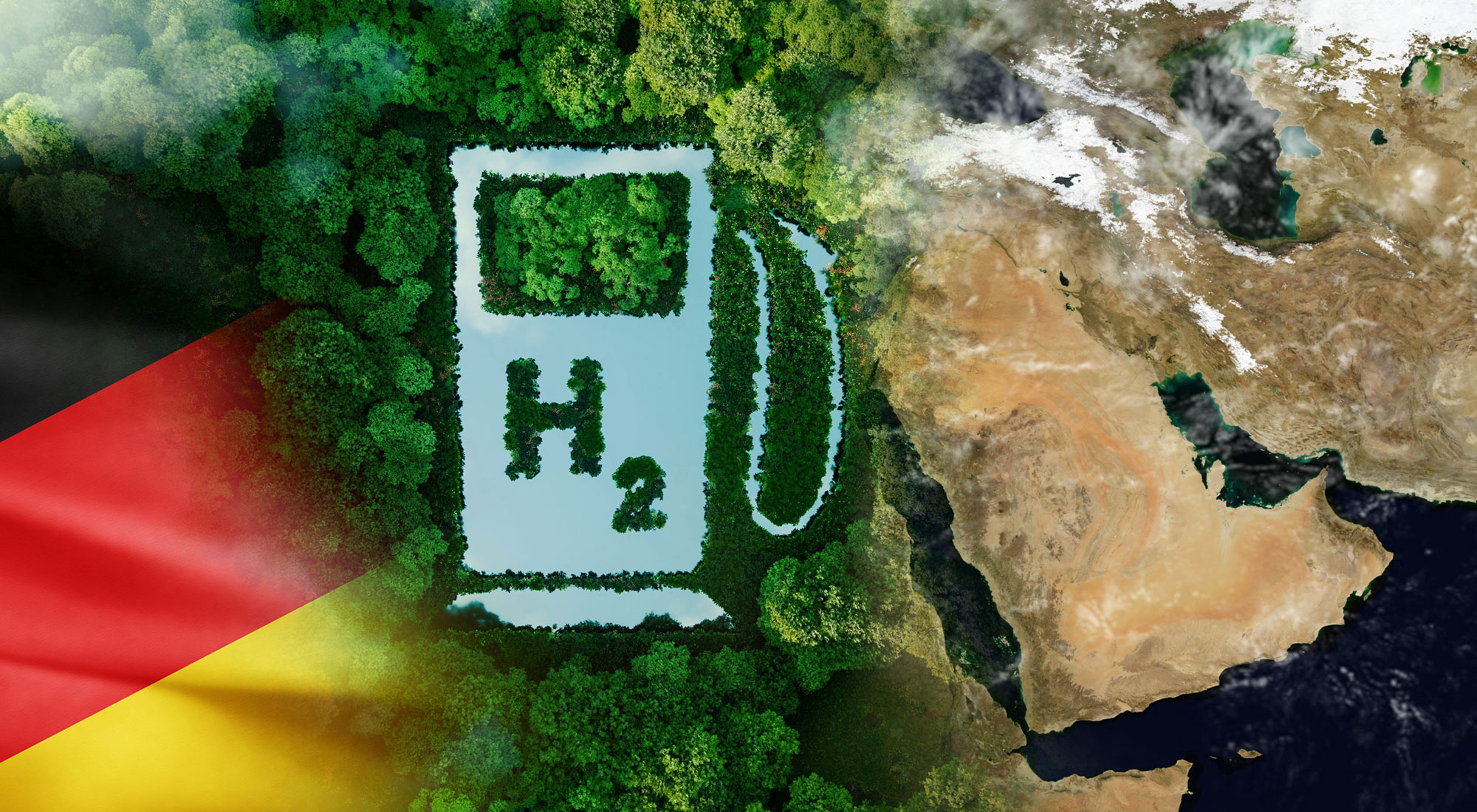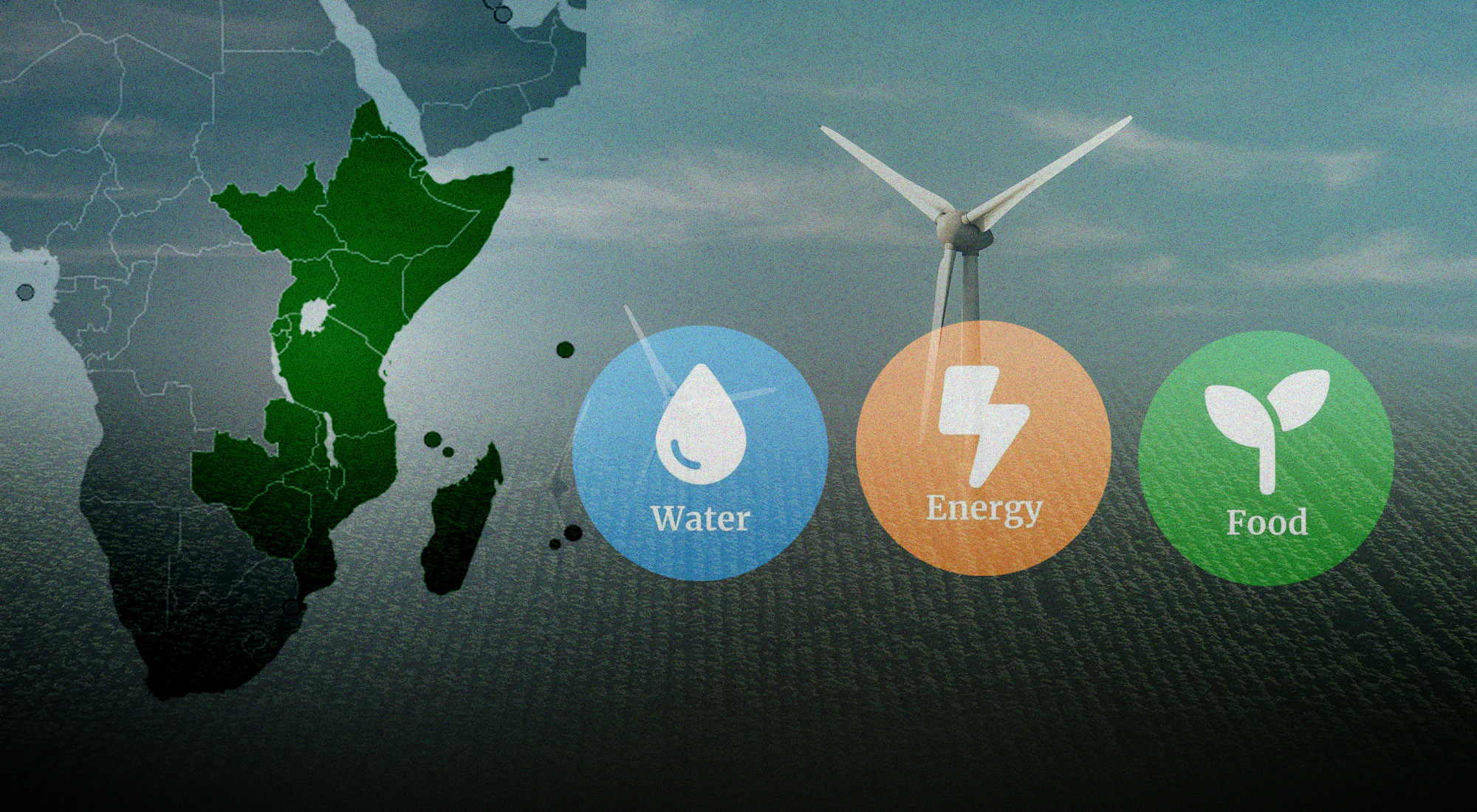Introduction: The hydrogen race
In late September 2022, Germany’s Chancellor Olaf Scholz visited Saudi Arabia, Qatar and the United Arab Emirates (UAE). During his visit to the UAE, he planted a tree in a mangrove park in recognition of the efforts toward more climate action and a cleaner energy future. His real motive, however, was rather different. Due the war in the Ukraine, Germany is desperately looking for new gas suppliers to reduce its dependence on Russia in the short term. Additionally, it is seeking out hydrogen supplies from the Gulf, which was also discussed during the Chancellor’s two-day visit.
Over the last two years, hydrogen has been presented by policymakers and experts worldwide as the new ‘technological fix’ and an integral part of the fight against climate change. Hydrogen comes in many different colors. Currently, more than 95% of hydrogen production comes from fossil fuels. The most common form is ‘gray hydrogen’, where hydrogen is produced via steam methane reforming. ‘Brown hydrogen’ is the cheapest but most polluting form, which includes the use of coal in the gasification process. In contrast to these two environmentally damaging production methods, ‘blue hydrogen’ – though produced through steam methane reforming – captures carbon emissions, which are then stored or reused. Lastly, ‘green hydrogen’ splits water into hydrogen and oxygen via electrolysis, which is a process powered by renewable energy sources.
Leading industrial countries around the globe have already positioned themselves in the race for this future energy technology. However, several shortcomings, uncertainties and risks remain. By using the example of Germany’s latest efforts in enhancing hydrogen infrastructure and diplomacy in the Gulf states, this article discusses some of these limitations. It criticizes Germany’s overhasty decisions and argues that policymakers should reconsider their bet on hydrogen instead of hoping (or assuming) that all open questions and uncertainties will be resolved soon. In order to establish a sustainable hydrogen partnership, a more comprehensive approach should be considered. This would help countries in their specific energy transition and redirect focus on tackling some of the underlying root causes, which currently make large-scale low-carbon hydrogen production unrealistic.
Germany, the Gulf and the quest for hydrogen
In light of its recently announced climate targets, Germany seeks to reduce emissions by 65% by 2030 (compared to 1990 levels). Its heavy industrial sector (e.g. steel, aviation), in particular, demands large amounts of hydrogen. In June 2020, the German government issued the National Hydrogen Strategy, which outlines future demand, production, and industrial use of hydrogen. A year later, the initial goal of producing at least 5 gigawatts by 2030 was doubled to 10 gigawatts. Since it is clear that domestic production will not sufficiently meet this demand, it is expected that Germany will rely heavily on importing hydrogen. Thus, the Gulf region could play a leading role as major hydrogen supplier.[1]
Accordingly, the German government has recently been very active in partnering with several Gulf states to make new hydrogen deals. In 2021, German and Saudi policymakers signed a memorandum of understanding within the scope of the German-Saudi Energy Dialogue that foresees Germany’s provision of hydrogen technology (i.e. electrolysis systems) in exchange for green hydrogen exports to Germany. The German Federal Foreign Office, in cooperation with the Deutsche Gesellschaft für Internationale Zusammenarbeit (GIZ) GmbH, further opened a hydrogen diplomacy office in the Saudi capital.[2] In 2020, a German hydrogen company, Hydrogen Rise AG, signed a memorandum of understanding with Oman Educational Services LLC to create a joint venture to facilitate hydrogen development.[3] In the same year, the Oman Hydrogen Centre was launched at the German University of Technology in Oman (GUTech) as a center for research and knowledge in hydrogen technology. In the summer of 2022, when Oman’s Sultan Haitham bin Tarik visited Germany, state officials from both countries signed a declaration of intent for closer cooperation in green hydrogen and its derivatives.[4]
As part of the German-Emirati Energy Partnership of 2017, the German-Emirati Chamber of Industry and Commerce (AHK) in Abu Dhabi and the Berlin-based consultancy company Guidehouse launched the Emirati-German Hydrogen Task Force in November 2021. Shortly afterwards, four hydrogen cooperation projects were agreed on between the UAE and Germany. Interestingly, and in contrast to the agreements in the other Gulf states, cooperation with the UAE envisages “initially” using blue hydrogen and its derivates (e.g. ‘blue’ ammonia) that “will quickly be replaced by ‘green’ hydrogen”[5] – though the German government did not mention a specific timeline or detailed plan on how long blue hydrogen will be used as a transition fuel until it is replaced by green hydrogen. However, it is projected that, in an ideal situation, green hydrogen will have the lion’s share with 70% of the annual production, with blue hydrogen constituting the remaining 30% and grey hydrogen being completely phased out.[6]
The Gulf states are in an advantageous position and have great potential for producing large quantities of hydrogen. This is due to not only their geopolitical location bordering Europe, Asia and Africa but also their status as having some of the world’s highest solar irradiances. With their vast landscapes, they provide the perfect conditions for large-scale solar power operations and green hydrogen production. In terms of blue hydrogen, the conditions are even better. The abundance of natural gas, low production costs, existing infrastructure and equipment as well as immense storage capacity potential make them ideal for producing large quantities of gray hydrogen with carbon capture and storage (CCS). On the downside, they lack the technology and resources for building hydrogen plants, which is why local state-affiliated companies and institutions often collaborate with external partners and suppliers.
Over the last years, Gulf states have responded to the growing demand for hydrogen and have announced several projects. One example includes the construction of a green hydrogen plant in Saudi Arabia’s future NEOM city, led by Saudi-based ACWA Power and US-based Air Products. The plant will use German technology provided by ThyssenKrupp and will be powered by 4 gigawatts of renewable energy to produce green ammonia (a specific hydrogen-based energy carrier). Plans for green hydrogen are even bigger in Oman as the government recently announced plans to build the world’s largest green hydrogen plant. The planned plant will be powered by 25 gigawatts of wind and solar energy to produce green hydrogen, which will then be exported to Asia and Europe. Other planned projects include facilities in Sohar, Duqm and Salalah, led by local Omani companies and external partners, including a subsidiary of the Kuwaiti sovereign wealth fund and the Hong Kong-based InterContinental Energy.
Since 2021, the UAE has been running the first green hydrogen plant in the region. The small-scale facility is connected to the large Al Maktoum Solar Park in Dubai and operated by the local utility supplier DEWA and Germany’s Siemens Energy. Further plans foresee similar projects producing green hydrogen and its derivates through joint ventures, with local entities partnering with French and British companies as well as a number of Germany’s big industrial players such Siemens Energy, ThyssenKrupp, or Lufthansa.[7]
In addition to green hydrogen investments, Saudi Arabia and the UAE have unveiled several blue hydrogen projects. Notable are plans for a facility near the Jafurah gas field in the Saudi Eastern province and plans by the Emirati oil company ADNOC to develop the world’s largest blue ammonia plant close to the industrial city of Ruwais.[8] It is expected that these facilities will start production in 2024 and 2025, respectively.
Unresolved questions and uncertainties
Despite formalized agreements and projects becoming increasingly tangible, a number of risks and uncertainties are still associated with the production of hydrogen. These can be divided into (a) economic cost and inefficiency; (b) doubts about production capacity and capabilities; (c) potential security issues; and (d) (unintended) environmental and climate risks. First, hydrogen production is expensive. According to the International Energy Agency (IEA), in 2020, green hydrogen was priced at 10.2 cents per kilowatt hour (Ct/kWh), which is significantly more expensive than blue hydrogen (6.3 Ct/kWh) and gray hydrogen (4.7 Ct/kWh).[9] A surge in global hydrogen demand will also increase the competition over raw materials and components to develop green hydrogen infrastructure. Currently, raw material suppliers and providers of electrolysis technology are exclusively based outside of Germany and the Arabian Peninsula.[10] Global suppliers of the required raw materials such as nickel or platinum group metals (platinum and iridium) are located in China, Russia, Indonesia, Australia, and the Philippines, as well as in Africa (especially South Africa but also Zimbabwe).[11]
Furthermore, blue hydrogen is not a viable alternative for now. Obstacles like the cost of the equipment needed to capture and pressurize carbon dioxide, as well as the logistical hurdle of transporting the material to a storage site are the main reasons why it has developed at a slow pace and might not be commercially available before 2025.[12] Needless to say, the Gulf states do have a cost-competitive advantage: in addition to the the abundance of oil and extensive experience in gas exploration, they can utilize carbon sequestration (i.e. carbon capture, utilization and storage – CCUS) in the form of carbon dioxide enhanced oil recovery (EOR), whereby the captured carbon is reinjected to extract more oil or gas. Today, EOR is the only form of large-scale, permanent carbon sequestration that is profitable.[13] As a corollary, as more oil and gas is enhanced, this will ultimately lead to more greenhouse gas emissions. There are also other concerns that question the overall potential of CCS and, therefore, also blue hydrogen. For instance, the process does not capture all carbon dioxide. The most efficient ones can capture 90-95% while others have a lesser rate of only 60% or slightly higher.[14] Additionally, there are practical shortcomings of storing the carbon emissions properly. This is even more the case for CCUS as the emissions are utilized and not directly and permanently stored deep underground. Leakages are likely and, even a very small rate of just over 1%, would make the whole process of carbon sequestration useless.[15] In short, there is no robust evidence that CCS/CCUS will be substantially effective in achieving deep decarbonization.[16]
Second, in addition to the overall question of commercial feasibility and its role in a climate transition, there are concerns about the capacity to produce large amounts of green hydrogen as “the feedstock electricity has to be renewable and water sustainably sourced.”[17] Even though Gulf countries have made large investments in expanding their renewable energy potential, above all the UAE, the overall share of installed non-hydrocarbon power capacity remains low.[18] This raises the question as to whether the small amount of clean energy produced should be used domestically instead of being allocated to green hydrogen production, which is then exported. Another question that remains is the water demand required to produce green hydrogen. In mostly arid areas, water scarcity constitutes a great challenge. In order to meet their growing water demand, Gulf countries exploit their non-renewable groundwater reserves or heavily rely on desalination to produce freshwater. Yet, both are not sustainable solutions. Desalination, in particular, has several further shortcomings: it is expensive, energy intensive, and carries environmental risks as by-products such as brine and other chemicals are released or dispersed into the seas. At the same time, more greenhouse gases are produced because most of the desalination plants are powered by burning fossil fuels. Currently, Gulf countries are working on developing more sustainable desalination technologies but they are simultaneously expanding their conventional desalination capacities for a number of reasons: a rise in demand due to demographic growth, the increasing salinization of the seas and oceans (as a result of brine discharge) and a climate-induced rise in harmful algal blooms that can disrupt desalination processes, just to name a few.[19] Lastly, and paradoxically, the large-scale investments in water-intensive clean technology (including green hydrogen) fuel this unsustainable vicious cycle.
Third, potential security threats have not been part of larger public debates thus far. Hydrogen is highly flammable and explosive; one only has to remember the massive explosion of the hydrogen-filled zeppelin Hindenburg in 1937. Secure transportation and trading routes are essential but have barely been discussed. It is expected that hydrogen exports from the Gulf to Europe will be transported via ships, and not pipelines, as this is more cost-efficient. In order to ship it, hydrogen needs to be liquified, a process that is, again, highly costly and energy intensive. A cheaper and easier way is to use ammonia as a carrier, but it is highly toxic, flammable, and corrosive. Moreover, leaked ammonia can cause acid rain. Thus, it is essential that safe transport is ensured, but in such a fragile environment as the Gulf, it is unclear how this can be done. Previous attacks on oil facilities and ships, as well as the recent potential acts of sabotage against the gas pipelines North Stream I and II, indicate the high vulnerability of the global energy infrastructure, which should be carefully considered when producing and transporting hydrogen.
Lastly, there are climate change-related problems and uncertainties concerning natural living conditions. Although the secondary environmental effects of hydrogen are yet to be analyzed more thoroughly, there are mounting concerns that hydrogen may not be as clean as widely assumed. For instance, there are indirect warming impacts as the oxidization of hydrogen in the atmosphere leads to increasing concentrations of greenhouse gases. It is estimated that hydrogen emissions (H2) could be “200 times that of carbon dioxide and larger than that of methane.”[20] In terms of blue hydrogen, the ecological record is even poorer. Throughout the value chain, blue hydrogen can produce damaging emissions through leakages, venting and purging as additional amounts of carbon dioxide (CO2) and methane (CH4) can escape.[21] Furthermore, carbon sequestration, which is a prerequisite for producing blue hydrogen, could potentially lead to ecological risks such as soil erosion, toxicity, eutrophication, and acidification.[22] Depending on the geological site in which the carbon emissions are stored, leakages can infiltrate groundwater aquifers and contaminate freshwater resources with dangerous uranium and barium.[23]
Conclusion: A more comprehensive and nuanced hydrogen partnership
Despite the myriad of security, commercial, economic, and ecological limitations and uncertainties, Germany has been very active in forming new hydrogen partnerships with countries in the Gulf. Although the Intergovernmental Panel on Climate Change (IPCC), as well as many climate experts, suggest that hydrogen and technologies like carbon capture are important steps in achieving the climate targets of the Paris Agreement, many open questions remain. Indeed, it is reasonable to expect green hydrogen to be produced at the same price as gray hydrogen, with more actors competing for low-cost development. However, the speed and scale at which the German government is pushing forward with these technologies indicate more an intent to defend its status as an economic power and attractive industrial center rather than a green leader with ecological responsibility. This is best illustrated in Germany’s turnaround in March 2022 when the Federal Minister for Economic Affairs and Climate Action Robert Habeck from the Green Party agreed to “initially” use blue hydrogen, which would “quickly be replaced by ‘green’ hydrogen.”[24] This increases chances of a lock-in effect, in which blue hydrogen is not a transition technology but becomes a major component of the energy system. For a much-needed climate transition that limits global warming to at least 2 degrees Celsius to avoid any cascading ecological effects (i.e. tipping points in the climate system), this comes as bad news.
Before declaring hydrogen as the ‘all-purpose cleaner’ to fight the climate crisis, it is necessary to carefully evaluate all associated potential threats and shortcomings. Particularly in the case of blue hydrogen, there is no evidence-based record of it being a climate-friendly solution. Policymakers should reflect on and address the uncertainties and complexities of hydrogen production instead of rushing to sign new energy partnerships and hydrogen deals. While this appears economically rational in an insecure time of energy supply and uncertain outlook of a low-carbon development, it is not farsighted as it might even exacerbate global warming and environmental degradation instead of solving it.
Furthermore, countries like Germany can go beyond the current technical and diplomatic hydrogen cooperation, which only satisfies its own future hydrogen demand. For instance, it can help to advance research and analysis on mitigating the associated risks and engage in knowledge-sharing. This also includes a critical and realistic assessment on how to ensure safe transport routes and prevent all forms of leakage. Germany can also assist in tackling some of the root causes that currently make hydrogen a difficult ‘technological fix’. This includes research and development on wastewater treatment, sustainable disposal of brine, and more sustainable desalination plants that are less energy-intensive and powered by renewable energy sources. Facilitating strategic investments and capacity building to increase clean energy projects in the region could be another entry point to a more comprehensive hydrogen partnership.
Lastly, instead of hoping for CCUS/CCS to become non-hazardous and commercially feasible, natural-based solutions to decarbonization should be advanced and promoted. Here, Germany could increase efforts to assist local tree planting initiatives (especially mangroves). Above all, in order to seriously tackle the climate crisis, policymakers should not solely count on technology and innovation but also impose measures to bolster energy efficiency as well as a general change in consumption habits.
References
[1] Matthias Schimmel, Diego Bietenholz, Karoline Steinbacher et. al., Hydrogen Cooperation Potential between Saudi Arabia and Germany. A Joint Study by the Saudi-German Energy Dialogue, A Joint Report by Guidehouse Germany GmbH, King Abdullah Petroleum Studies and Research Center (KAPSARC), and King Abdullah University of Science and Technology (KAUST) for the German Federal Ministry for Economic Affairs and Climate Action (BMWK) and the Ministry of Energy Saudi Arabia (MoEnergy), June 2022, http://bitly.ws/vnNu.
[2] German Federal Foreign Office, “Hydrogen Diplomacy Office Opening in Saudi Arabia,” February 27, 2022, http://bitly.ws/vnNG.
[3] Conrad Prabhu, “Omani-German Joint Venture to Support Hydrogen Investment,” Oman Observer, January 27, 2020, http://bitly.ws/vnNK.
[4] Oman News Agency, “Oman, Germany Sign Declaration of Intent in Energy Field,” Oman News Agency, June 14, 2022, http://bitly.ws/vnNR.
[5] German Federal Ministry for Economic Affairs and Climate Action, “Federal Minister Robert Habeck: ‘Expand Cooperation on Hydrogen with United Arab Emirates,” March 21, 2022, http://bitly.ws/vnP6.
[6] Hydrogen Council and McKinsey & Company, Global Hydrogen Flows: Hydrogen Trade as a Key Enabler for Efficient Decarbonization, October 2022, http://bitly.ws/vnPg.
[7] Mohamed Al Ramahi, “Masdar Will Be Abu Dhabi’s Clean Energy Powerhouse,“ The National, January 16, 2022, http://bitly.ws/vnPm.
[8] Dawud Ansari, “The Hydrogen Ambitions of the Gulf States Achieving Economic Diversification While Maintaining Power,” SWP Comment No. 44, Stiftung Wissenschaft und Politik, July 21, 2022, http://bitly.ws/vnPt.
[9] Dominik Schäuble, Joschka Jahn, Lorenzo Cremonese et. al., “Internationale Wasserstoffpolitik: eine kurze Bestandsaufnahme anlässlich der ‘Gesprächsrunde zu möglichen Elementen einer Wasserstoffaußenpolitik‘ veranstaltet vom Auswärtigen Amt und IASS Potsdam am 04.03.2020,“ IASS-Potsdam Discussion Paper (2020), https://doi.org/10.2312/iass.2020.006.
[10] Dawud Ansari, Julian Grinschgl and Jacopo Maria Pepe, “Electrolysers for the Hydrogen Revolution: Challenges, Dependencies, and Solutions,” SWP Comment No. 57, Stiftung Wissenschaft und Politik, September 29, 2022, http://bitly.ws/vnPY.
[11] Ibid.
[12] Joseph Romm, Climate Change: What Everyone Needs to Know (Oxford: Oxford University Press, 2022).
[13] David Roberts, “Could Squeezing More Oil out of the Ground Help Fight Climate Change?” Vox, December 6, 2019, http://bitly.ws/vnQ5.
[14] Schimmel et. al., Hydrogen Cooperation Potential between Saudi Arabia and Germany. A Joint Study by the Saudi-German Energy Dialogue.
[15] Ansari et. al., “Electrolysers for the Hydrogen Revolution: Challenges, Dependencies, and Solutions.”
[16] Christophe McGlade and Paul Elkins, “The Geographical Distribution of Fossil Fuels Unused When Limiting Global Warming to 2 °C,” Nature 517 (2015), https://doi.org/10.1038/nature14016.
[17] Schimmel et. al., Hydrogen Cooperation Potential between Saudi Arabia and Germany. A Joint Study by the Saudi-German Energy Dialogue.
[18] Aisha Al-Sarihi and Noura Mansouri, “Renewable Energy Development in the Gulf Cooperation Council Countries: Status, Barriers, and Policy Options,” Energies 15, no 5 (2022): 1923, https://doi.org/10.3390/en15051923.
[19] Shweta Nair, “Drinking Water Is Becoming Scarce. Is Desalination the Middle East’s Solution?” Fast Company, September 27, 2022, http://bitly.ws/vnQm.
[20] Ilissa B. Ocko and Steven P. Hamburg, “Climate Consequences of Hydrogen Emissions,” Atmospheric Chemistry and Physics 22 (2022): 9350, https://doi.org/10.5194/acp-22-9349-2022.
[21] Ibid.
[22] Pieter Roefs, Michele Moretti, Kris Welkenhuysen et. al., “CO2-enhanced Oil Recovery and CO2 Capture and Storage: An Environmental Economic Trade-off Analysis,” Journal of Environmental Management 239 (2019): 167-177, https://doi.org/10.1016/j.jenvman.2019.03.007.
[23] Ansari et. al., “Electrolysers for the Hydrogen Revolution: Challenges, Dependencies, and Solutions.”
[24] German Federal Ministry for Economic Affairs and Climate Action, “Federal Minister Robert Habeck: ‘Expand Cooperation on Hydrogen with United Arab Emirates,” March 21, 2022, http://bitly.ws/vnP6.








